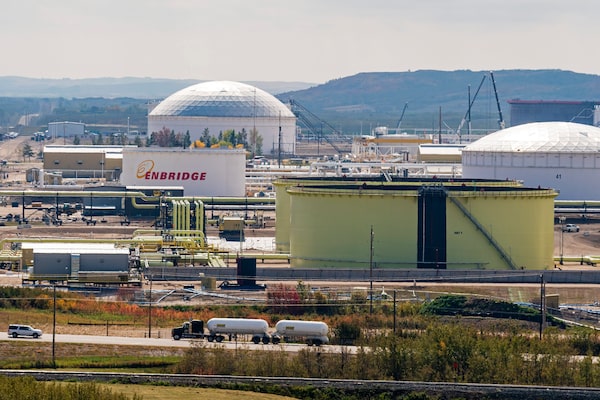
Enbridge and Gibson Energy petroleum storage tanks and pipelines at the Canadian energy storage and pipeline transportation hub in Hardisty, Alberta on Sept. 11, 2018.Bayne Stanley/The Canadian Press
The plan to cut production in the oil patch seems to have brought about a near-miraculous recovery in Alberta crude prices, but energy investors aren’t buying it.
In less than two weeks since the province of Alberta ordered oil companies to curtail output starting in the New Year, Western Canadian Select (WCS) has nearly doubled in price, taking a huge discount on Canadian oil back down to normal levels.
Oil and gas stocks, on the other hand, have not only sat out the commodity rebound, they have continued to decline. The S&P/TSX Composite Energy Sector Index is down by 2 per cent since production cuts were announced, leaving the sector’s total loss at 21 per cent since July.
The divergence suggests investors are doubtful that the homegrown oil crisis is over, said Rafi Tahmazian, a portfolio manager at Canoe Financial in Calgary.
“No sophisticated energy investor is going to invest in a country that has this kind of turmoil.”
Canadian oil prices collapsed over the summer and fall as a shortage of pipeline capacity left producers scrambling to find alternative ways of getting their oil to market.
With Alberta’s oil output at record levels, and with a key U.S. Midwest refinery offline for more than two months starting in September, the industry increasingly resorted to shipments by rail and even by truck, while storage tanks were filled to capacity.
The confluence of setbacks slashed prices on Canadian heavy crude by 75 per cent over four months, as WCS sank to a low of US$13.46 a barrel in mid-November, opening up a differential against U.S. crude as high as US$50 a barrel.
Western Canadian Select is the main price benchmark for Alberta heavy crude oil. The price that individual producers receive for their oil depends on a number of factors, including the quality of the crude and the cost to transport it.
Estimating the cost of the oil price gap on the Canadian economy of $80-million every day, Alberta Premier Rachel Notley said the province would intervene in the oil market to ease the supply glut. About 325,000 barrels a day – 8.7 per cent of the Alberta’s oil-patch output – will be cut starting next month.
Ms. Notley suggested that the move would reduce the oil price differential by US$4 a barrel. That turned out to be a wildly conservative estimate.
WCS has nearly doubled in price since the announcement, to rise north of US$40 a barrel for the first time since September. The discount against West Texas Intermediate, meanwhile, has shrunk to US$12 – well below the long-term average of around US$17.
Considering that the mandatory production cut has not even taken effect, and does little to address the sector’s fundamental problems, Canadian oil is unlikely to maintain its new-found strength, said Judith Dwarkin, chief economist at RS Energy Group.
“This is simply a stopgap measure. We'll still have a full pipeline and more demand than there is takeaway capacity.”
The exaggerated oil-price rally was partly a reversal of what was an excessive slide fuelled by heavy competition for limited pipeline space, Ms. Dwarkin said.
“Getting on the pipeline every month that doesn't have enough capacity for all comers causes prices to collapse as desperation mounts,” she said. “It’s like musical chairs.”
Rather than adding a chair in the form of a new pipeline, curtailing production removes a player from the game.
Mr. Tahmazian added that "curtailment did a financial manoeuvre on pricing. It didn’t bring back the investors.”
Government intervention in oil production, while welcomed by some industry analysts and executives as a necessary move, makes it even more difficult to put a value on Canadian energy companies, which were already saddled with the uncertainty of Canada’s pipeline saga.
“We've been out of the Canadian E&P space for more than a year,” said David Sherlock, portfolio manager at SAGE Connected Investing in Calgary. “Not until we get clarity on pipelines. And I think there are other folks around the globe that are thinking that way.”
On the other hand, Brian See, a portfolio manager at CIBC Asset Management, said the mandatory production cut will go a long way to rebalancing the market, which is also being facilitated by rail shipments of crude and the return of refinery capacity.
“We think it’s more of an opportunity to pick up higher-quality names at attractive valuations,” Mr. See said, citing Cenovus Energy Inc. and Canadian Natural Resources Ltd., both of which are down by 27 per cent from their respective 52-week highs.
 Tim Shufelt
Tim Shufelt